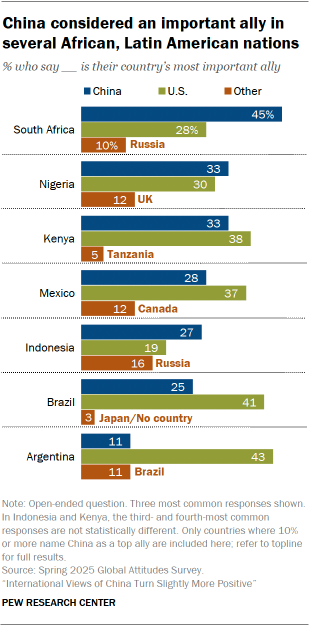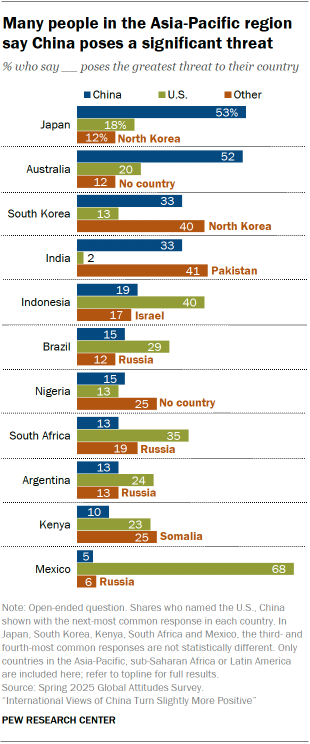We asked respondents in 25 nations to name the country they see as the most important ally to their own and, separately, which country poses the greatest threat. Both questions were open-ended, so respondents were able to name anything that came to mind.
In many countries, China ranks among the top allies and top threats.
- In every country surveyed in sub-Saharan Africa and Latin America, China is one of the top three most-mentioned allies.
- In some middle-income nations, China is more likely to be seen as an ally now than it was in 2019, when we asked a similar question.
- China particularly stands out as a top threat in the Asia-Pacific countries surveyed. Still, it’s among the top three threats named in most places surveyed.
- In general, people who think China poses the greatest threat to their nation tend to see it as both an economic and security threat.
China as an ally

China ranks among the top three most-mentioned allies in eight countries, including all of those surveyed in sub-Saharan Africa and Latin America.
In Indonesia and South Africa, China is named more than any other country.
In Kenya and Nigeria, similar shares name China and the U.S.
In Brazil and Mexico, about a quarter of adults name China as their top ally (second to the U.S.). Fewer Argentines see China as an important ally, though it is still the second most-mentioned country (tied with Brazil).
Views over time
We asked a similar question in 2019: “Which country can your country most rely on as a dependable ally in the future?”
While the 2019 question is a bit different than this year’s version, the balance of opinion has shifted markedly in some countries.
For instance, South Africans today are significantly more likely to name China than the U.S. as their country’s most important ally. (45% vs. 28%). But in 2019, the U.S. was the most common response, followed by China.
The trend in Indonesia is similar. In 2019, Indonesians were more than twice as likely to name the U.S. than China as their country’s top ally (16% vs. 6%). But today, more name China than the U.S.
China as a threat

When asked which country poses the greatest threat to their own, relatively large shares in several countries name China.
This is especially the case in the Asia-Pacific region: About half of adults in Japan and Australia say China poses the greatest threat to their country, making it by far the most common response. In South Korea and India, one-third call China their top threat, second to North Korea and Pakistan, respectively. And roughly two-in-ten Indonesians say China is their greatest threat, second to the U.S.
In each of the Latin American countries surveyed, China ranks in the top three threats, though never as the top threat. China is the second-most commonly named threat in Brazil (15%) and Argentina (13%), after the U.S. In Mexico, a notable 68% majority say the U.S. poses the greatest threat to their country, compared with 5% who say it’s China.
China is the third-most commonly mentioned threat, behind Russia and the U.S., in several high-income European countries surveyed. In the U.S. and Canada, it ranks first and second, respectively.
For more on perceived threats across regions, read “People in Many Countries Consider the U.S. an Important Ally; Others See It as a Top Threat.”
Views over time
We asked a similar question in 2019: “What country or group poses the greatest threat to your country in the future?” In some countries, how China ranks relative to the U.S. has shifted. For example:
- In Indonesia, more called China a threat than the U.S. in 2019. Today, the opposite is true.
- In South Africa, roughly equal shares in 2019 described China and the U.S. as threats. Now, the U.S. is far and away the most commonly named threat.
- In Canada, more named China than the U.S. in 2019, while the opposite is true – and by a sizable margin.
In the U.S., where we asked the same question in both 2023 and 2025, views of China as a threat have tempered slightly, though in both years it was named more than any other country. This decline is particularly steep among Democrats and Democrat-leaning independents (-12 points). In fact, Democrats are now more likely to name Russia as the greatest threat to the U.S., rather than China.
Related: Negative Views of China Have Softened Slightly Among Americans
China as an economic and security threat
We asked those who name China as their country’s greatest threat to rate how much of an economic threat China poses to their own and, separately, how much of a security threat it poses. In most countries where China is a common enough response for us to analyze, it’s seen as both an economic and security threat.
For example, 64% of Americans who say China is their country’s greatest threat say it poses a great deal of economic threat, while 61% say it’s a threat to national security. Views are similar in Argentina, Australia, Brazil, Canada, India, Indonesia, Kenya, South Africa, South Korea and the UK.
In Italy and Nigeria, China is perceived as more of an economic threat than a threat to national security. For instance, 43% of Nigerians who see China as the top threat think it poses a major threat to their country’s economy; just 19% say it poses a major threat to national security.
Japan is the lone country where there is greater concern about China as a security threat an economic one (54% vs. 41%, among those who name China as their top threat).




